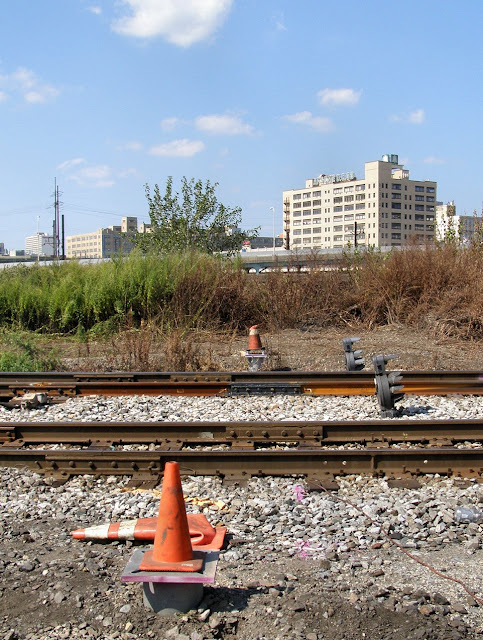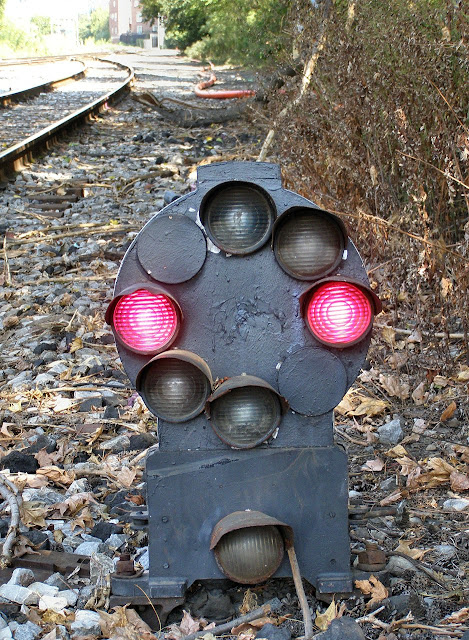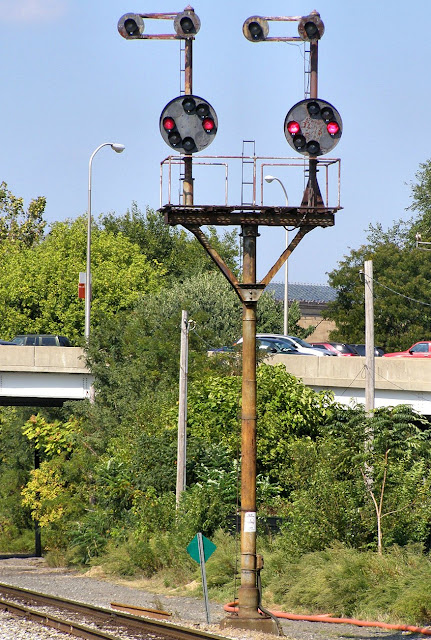Well once again it is time to turn some hum drum interlocking photos into some sort of cohesive narrative on signaling. In today's installment I bring you VINE and LOCUST interlocking on CSX's Philadelphia Subdivision. These two interlockings are located back to back about 1/2 mile from eachother on the former Baltimore and Ohio line along the Schuylkill River in Philadelphia. Located just 600 feet from the far more impressive Pennsylvania Railroad Northeast Corridor and its 30th St Station, the B&O line was always a distant second in the City's transportation pie...taking you the same places the PRR could, just in a lot longer time.
Now technically the B&O line ended at VINE, but during the golden age of railroading the line made a connection with PRR antagonist Reading Company which had an alliance with the B&O to allow it access to the major New York area market. Now as I said the B&O's route between Washington DC and New York was hopelessly outclassed by the PRR's mega main line, even more so after the latter built tunnels directly into the heart of Manhattan and then electrified the whole kit and kaboodle. Their response was to try to compete on quality of service in the form of the daily Royal Blue service. This train would be handed off to the Reading at Philadelphia, then take Reading tracks to Bound Brook, NJ where there would be another hand off to Reading subsidiary Central RR of New Jersey, which would then take the train to its final destination in Jersey City where the passengers would leave their super luxurious train and board a deluxe...*sigh*...bus, to go the last few miles to Midtown Manhattan. Needless to say this train did not survive long into the era of the Eastern Shuttle between NY and DC.
Now this stretch of track along the east side of the River had two main uses. The first was passenger service with the B&O's 24th Street station located right there. The second was freight traffic to and from New York via the Reading, but the 1976 consolidation of the bankrupt Reading into Conrail ended these movements. Even in 1999 when CSX bought half of Conrail to regain access to New York, most traffic ended up bypassing this stretch via a connection to the West Philadelphia Elevated due to the clearance restrictions caused by the Art Museum tunnel. The upside of all this irreverence has been that since whatever signaling associated with the 24th St station was removed in the Chessie System era, what they put in for replacement has stayed intact to this day and that mean, you guessed it, the whole corridor is sprinkled with B&O style colour position light signals.
Now despite these two interlockings being located in a deep depression adjacent to the river on one side and a retaining wall for the city centre on the other, the City was awesome enough to install a Multi-Use Trail between the tracks and the river, allowing near perfect access for the purpose of documenting the signaling there. There's even a cute little level crossing for the pedestrians and cyclists, but more on that later.
Anyway we begin with LOCUST interlocking which is named for proximity to Locust St. LOCUST consists of a basic crossover and the western end of the old B&T Philadelphia terminal area between here and RG Tower where the freight yard is located. South of LOCUST in addition to the two main tracks there is also #3 and #4 Running track which are used to park freight trains for various reasons. In this photo we see the westbound CPL dwarf signals, which are dark due to approach lighting, and a freight train way in the distance parked on the running track. The principle freight traffic that uses this line are municipal waste trains to and from large transfer stations in New Jersey and Staten Island that cart away the endless stream of refuse from New York City en-route to points south. The running tracks are a popular place for CSX dispatchers to park returning empty trains until they are needed up north.
The track #1 CPL dwarf consists of a full central target with the 12 and 2 o'clock orbitals attacked. The 12 being for straight routes and the 2 for an Approach Slow for mores at GREYS FERRY interlocking. If you are wondering about diverging moves at LOCUST itself the switches only good for 10mph, which is 5mph less than the official "Slow" speed so they have a special note in the Timetable. Diverging moves are covered by either a flashing | for Slow Clear or a solid | for Slow Approach Slow.
The track #2 dwarf is the same as the #1 dwarf except it lacks the 2 o'clock orbital for Approach Slow. GREYS FERRY has another one of those 10mph turnouts for diverging moves only from track 1 to 2 westbound so at LOCUST all that is needed is Slow Approach Slow, which does not light an orbital. The lunar white Restricting \ is displayed for movements into the non-circuited #3 running track.
Now a couple months later a cut of 85 foot flatcars each with 4, 1 TEU garbage cubes parked on #2 track was lighting up the dwarf signals. In this zoom shot you can see the interlocking along with another cut of 85 foot garbage flats which was probably split to avoid fouling the interlocking and the crossing.
Here we see each of the westbound CPL dwarfs lit up from a slightly off angle.
From the rear we see that the central head of the dwarf unit is secured
by a non-keyed bolt lock and the orbitals by just a threaded nut.
Since I had been there the last time one of the insulated rail joints
had been replaced. Today it is standard industry practice to
pre-assemble the insulated joints and then just cut out the old joint
and thermite weld the new one into place. The strange bases with the
cones on them was the reason I had targeted this interlocking for a full
documentation as they seemed to indicate an immanent re-signaling.
Rear view of both the westbound dwarfs showing also showing the new
joint and a GRS model 5H point machine. Also visible is the new
park/trail and related access from the road bridges.
Here we see the primary relay hut for the interlocking decorated in the
typical city fashion. The wooden pole in the foreground is for the ATCS
digital radio that replaced the CTC code line. The pebble stucco
building to the left is a repeater for the major fiber optic line that
uses the right of way between here and Baltimore.
Here we see a pair of new masts that had people assuming some sort of
re-signaling scheme. Fortunately, at the risk of ruining the suspense,
they were not part of a re-signaling project, but part of a grade
crossing protection scheme for the trail related crossings. Area
residents had been complaining about the noise of trains horns being
sounded for the two pedestrian/bicycle crossings and to mitigate this a
fixed, directional, horn system was being installed. These would sound
automatically based on some form of train detection and produce much
less noise pollution. The masts were to indicate to the engineer if the
system was functioning or not. If a yellow LED X is displayed on the
to-be-mounted mast unit the train needs to sound its own horn.
A second set were installed on the other side of the Locust St crossing.
Here we see the eastbound CPL dwarfs at LOCUST. As VINE consists of a
single equilateral turnout no off center orbitals are required here at
LOCUST. Of course because CSX can't pass up an opportunity to do
strange things the track #1 dwarf lacks even a 12 o'clock orbital
reducing its best indication to Slow Clear, even though the speed on
that track is for 30mph. ::rolls eyes::
Solo view of the "naked" track 1 CPL dwarf showing off the 10mph crossovers.
Similar view of the track #2 dwarf in the "inverse lollypop" configuration.
Judging by the backing plates on the track #2 signal we can assume that
there have been some replacements. Also the cover to the terminal box
is being held on by some zip ties. ::groans::
The track #1 dwarf at least seems to have all its original equipment.
Now just to make sure that all consistency is taken out back and shot
here we see that the exit CPL dwarf off #3 running will display a Medium
Clear (30mph) for the 10mph turnout via its 6 o'clock orbital. I think
we have officially descended into Route Signaling here with the
rulebook speeds of the signal indications being completely superseded by
timetable instructions.
#3 running CPL dwarf in relation to those of the main tracks.
New relay box at the east end of LOCUST next to a slightly less new box
next to an old school cabinet. Not sure what is used for what here, but
let's see if that CCTV camera can keep the new new box free of
graffiti. Somehow I'm not too optimistic.
Alright, that's enough of LOCUST, so let's walk the half mile down to VINE and see what's up there. Like LOCUST, VINE has another of those pedestrian crossings just outside of it, but VINE has proven itself a much more popular photo location for area railfans looking for some freight pictures to add to the normal passenger fare provided by Amtrak and SEPTA across the street. This popularity can be summed up in two words...Bracket Mast.
That's right, a classic B&O CPL equipped bracket mast governs
eastbound movements on both tracks. VINE is where two tracks squeeze
down to one to maximize clearance in the tunnel and while theoretically
unnecessary due to the low speeds on both main tracks the B&O or
Chessie System decided on installing a 40mph equilateral turnout. This
is one of three such equipped interlockings between Baltimore and
Philly where two main tracks are reduced to one. In this next pic we
see a wider view with the equilateral turnout, ATCS antenna attached to
the relay hut and Philadelphia Museum of Art in the background.
Neither CPL is equipped with a reduced speed orbital as
trains can proceed at timetable speed through the interlocking on either
track, but they do get a 10 o'clock Approach Medium orbital for
diverging routes at the back-to-back interlocking CP-PARK.
In this side view of the bracket mast we see the reason for the new
grade crossing warning system in the form of residential apartment
towers.
Getting a closer look at the back of the masts we see that both use the
second generation GRS junction box dating them to the 1970s.
Now what is perhaps the best punchline of this entire essay, take a look
at the permanent speed restriction marker for #2 main west at the
bracket mast. Yup, you aren't seeing things, the speed for #2 track is
19mph...19!! How does one arrive at a speed limit of 19, especially
when track #1 is 30. Talk about oddly specific and I am sure there is a
story behind it. For example at Portland, OR Union Station speed on
the station tracks is listed as 6 due to a typo made decades ago, but
issuing the required change notices has been deemed to be not worth the
effort.
Space between the trail, river and tracks became a bit congested under
the I-676 bridge so the fence had to be cut to fit the relay box
creating another railfan vantage point.
I mentioned before that until 1999 this was the division point between
first the Reading and B&O and later Conrail and CSX. Even tho
both lines have now been united under CSX this division is still evident
today by a rare double zero milepost. Here we see Milepost 0 with the
BBF CSX section prefix for eastbound trains passing through VINE.
And here we see Milepost 0 with the BAK CSX section prefix for westbound
trains passing through VINE. If you think that isn't confusing enough
there is ANOTHER Milepost 0 just 1.3 miles east of here at CP-PARK where the prefix resets again to QA.
Because this used to be an entry point onto CSX from Conrail there is an AEI reader at the westbound home signal.
Here we see the westbound mast at VINE. Note the Permanent Speed Restriction of 5mph on the river trail.
The CPL mast uses a first generation GRS terminal box.
Again, the use of an equilateral turnout means only the full speed 12 o'clock orbital is necessary.
Like LOCUST, all signals at VINE are approach lit. The bracket signals
were activated by the cut of garbage flats, but there is no such luck
for the mast and combined with the general backlighting this was the
best photo I could get.
Well, you've made it through another Marathon session of random interlocking factiods. If you have fallen asleep I implore you to tune in next time when I will be presenting a much more interesting program on the timetable method of operation on the Metra Beverly Sub.
A blog devoted to explaining the ins and outs of North American railroad signaling, past, present and future. This blog seeks to preserve through photo documentation the great diversity and technical ingenuity of 20th century signaling and interlocking hardware and technology. Related topics cover interlocking towers and railroad communications infrastructure.
Note, due to a web hosting failure some of the photos and links may be unavailable.




































"Orbitals"...interesting term for the marker light (which is what they are technically called).
ReplyDeleteI forget who started using that term, but it's a lot better than "marker light" which usually means a single lamp below the main head.
Delete